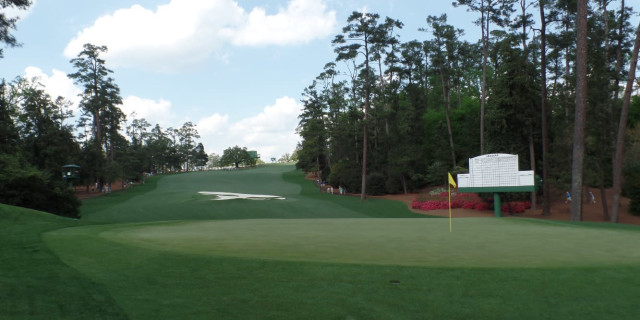
Complete Augusta National 18 Hole Course Guide
Augusta National has been extended since last year. It now measures 7,521 yards. Originally designed by Alister MacKenzie, it has been lengthened over the years and changed significantly in places since those early days.
This is how it shapes up:
- 1st: Tea Olive - Par 4, 445 yards
When the course opened in 1934 the nines were the reverse of what they are today, so this was the 10th hole. It originally measured about 400 yards but is now 45 yards longer. The fairway bunker on the right was moved nearer the green in 2001 while the one further up on the left was removed and a greenside bunker installed instead in 1950.
- 2nd: Pink Dogwood - Par 5, 575 yards
The changes that have been made over the years to this par 5 include narrowing the fairway and moving the fairway bunker from the left to the right and further from the tee. The hole was lengthened in 1999 but remains a great birdie opportunity if you find the fairway.
- 3rd: Flowering Peach - Par 4, 350 yards
The par four third hole is largely unchanged from MacKenzie’s original design. Flowering Peach, a native of China, is on the right side of the fairway. It blooms and double blooms in March and early April.
- 4th: Flowering Crab Apple - Par 3, 240 yards
A long par three that started life at 190 yards but has now been lengthened by 50 yards. It plays downhill - don’’t miss the green to the left.
- 5th: Magnolia - Par 4, 495 yards
It was extended by 40 yards in 2019 and is now the most difficult hole on the course. The two bunkers down the left have been moved over time and require a 313-yard carry. This hole shares its name with the lane that leads to the clubhouse at Augusta National.
- 6th: Juniper - Par 3, 180 yards
While many holes at Augusta have been lengthened, the sixth has actually been shortened by five yards. Once upon a time it featured a pond, which has now been filled in.
- 7th: Pampas - Par 4, 450 yards
When MacKenzie designed it he based it on the 18th at the Old Course at St Andrews, featuring the Valley of Sin. Byron Nelson drove the green in 1937 and the following year the green was moved, on top of a hill and featuring three green side bunkers. In the mid-1990s the green was enlarged and trees planted to narrow the fairway. In 2002, a new back tee added 40-45 yards to the hole, and in 2011 it was pushed back a further 40 yards.
- 8th: Yellow Jasmine - Par 5, 570 yards
The hole originally had a punchbowl green surrounded by hillocks, which made the putting surface blind for those attempting to get on this uphill par 5 in two, but visible to those taking a conventional three-shot approach. Augusta National Chairman Clifford Roberts thought the hillocks limited spectator sightlines so had them removed. The green was reshaped as a platform in a figure of eight. In 1957 the green was redesigned. After Roberts died, it was changed again.
- 9th: Carolina Cherry - Par 4, 460 yards
The original green was horseshoe-shaped around a bunker. Players found it easier to approach the green on this right-to-left dogleg from the first fairway, so the green was rebuilt and five bunkers placed left of the green in 1938. In the 1950s, trees were planted to further discourage players hitting to the 1st fairway. Parts of the green have been rebuilt at various times to provide more pin positions on the steepest green on the course. The hole has also been lengthened so approach shots are played from a hanging lie at the bottom of a valley.
- 10th: Camellia - Par 4, 495 yards

Now one of the toughest holes on the course, it is radically different from MacKenzie’s original design, with both the tee and green having been moved. When the course opened, the 10th measured 430 yards.
- 11th: White Dogwood - Par 4, 520 yards
The start of Amen Corner, the 11th used be a shorter, more severe dogleg, but it has been lengthened and straightened. The pond to the left of the green has ended the hopes of many players. Ahead of the 2022 Masters, the 11th tee was moved back 15 yards and to the left, and some trees down the right side of the fairway were removed.
- 12th: Golden Bell - Par 3, 155 yards
One of the most famous short holes in the world, the 12th is played over a pond to a narrow green that slopes from back to front. The real challenge comes from the swirling wind, making club selection extremely difficult.
- 13th: Azalea - Par 5, 545 yards
The Azaleas after which this hole is named provide a spectacular backdrop to this comparatively easy, downhill par five. Find the fairway and you will be expecting a birdie. But it could be more of a challenge this year, having been extended by 35 yards and making it harder for players to cut the dogleg.
- 14th: Chinese Fir - Par 4, 440 yards
The 14th is the only hole on the course without a bunker. The 14th tee was moved back 35 yards in 2002.
- 15th: Firethorn - Par 5, 550 yards
A greenside bunker was introduced for the 1957 Masters. The water in front of the green used to be a stream, but this has become a pond and the bank on its far side has been made slicker and steeper. It was extended by 30 yards in 2006 and a further 20 yards was added last year.
- 16th: Redbud - Par 3, 170 yards
There is a pond to the left of this two-tier green, which was the scene of Tiger Woods’ incredible holed pitch when he finished over the putting surface, pitched the ball to the top of the hill and watched his ball trickle its way down the slope and into the hole.
- 17th: Nandia - Par 4, 440 yards
A narrow, tree-lined par four which once featured the most famous tree in golf. A huge pine tree was a constant source of irritation for former President Dwight Eisenhower, who hit it so often that it became known as The Eisenhower Tree. It had to be removed in 2014 because of storm damage.
- 18th: Holly - Par 4, 465 yards
This closing holing plays sharply uphill and calls for an accurate drive. There are trees to the right and bunkers to the left before an approach to a two-tier green, which is well protected by bunkers.
Related Content
2023 Masters Preview, Picks, Analysis & TV Guide
About the author

Derek Clements is a seasoned sports journalist and regular Golfshake contributor, specialising in tour coverage, opinion pieces, and feature writing. With a long career in national newspapers and golf media, he has reported on the game across Europe, the United States and Australia. A passionate golfer, he has played and reviewed numerous renowned courses, with personal favourites including Pebble Beach, Kingsbarns, Aldeburgh, Old Thorns and the K Club. His love of the game informs his thoughtful commentary on both professional golf and the wider golfing community.

Be part of the action with a selection of unique golf tournament experiences, from playing in a pro-am with the stars to watching the action at golf’s most illustrious events. Whether it’s the Masters or The Open, The Ryder Cup or WM Phoenix Open, build your own bespoke package with the experts at Golfbreaks.com.
Tags: the masters Masters 2023 Masters










